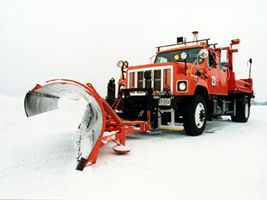 |
This Hutchinson-based
snowplow, part of Mn/DOT’s Intelligent Vehicle Initiative, got a workout
during the weekend storm. Operator Al Barnes said the plow’s on-board
electronic equipment enabled him to plow the shoulder along 30 miles of
Hwy 7 in spite of his visibility being reduced to near zero. The plow’s
"heads-up" display system enabled him to center the plow’s path
along the edge line and the radar system helped him avoid obstacles such
as mailboxes and road signs. Researchers will review videotape of the
plow’s performance to help determine the IVI vehicle’s overall effectiveness
during the storm.
|
Minnesota’s long-dormant winter arose with a fury on Friday and Saturday, mixing
rain, sleet, snow and bursts of wind that reached 60 miles an hour to close
roads, snarl traffic and keep Mn/DOT maintenance forces on high alert for many
hours.
High winds created most of the problems related to the storm, causing white-out
conditions in parts of southwestern Minnesota. Icy conditions were prevalent
in the Mankato and Rochester districts while the Duluth District received as
much as 15 inches of snow in some locations.
Two Mn/DOT snowplows were hit during the storm. No drivers were hurt and no
motorists were seriously injured. At times, some plows were taken off the road
because of near-zero visibility.
The Mankato District was forced to close Hwy 71 between Windom and Sandborn
because of low visibility. A district snowplow was struck on Hwy 71 and a semi-trailer
truck hit another snowplow on I-90.
Rebecca Arndt, public affairs coordinator, said the storm’s path created a
patchwork of areas that experienced high winds, icy roads and compacted snow
in varying and unpredictable patterns.
Dennis Marty, maintenance supervisor at Willmar, said wind-driven snow contributed
to two multi-vehicle crashes on Hwy 7 near Lake Lillian.
"In open areas, drivers couldn’t see and stopped on the road," Marty
said. "When they stopped, snow built up around them and other drivers couldn’t
see them, resulting in a collision or trucks and cars taking the ditch."
Mn/DOT crews spent about four hours on Saturday working with the sheriff’s
deputies, the State Patrol and two wreckers to pull the vehicles off the road
and onto the shoulder. A few hours later, Marty said, they were all called back
to another pile-up at the same location.
At Hutchinson, Jeff Butson, maintenance supervisor, said once the winds died
down, crews there were able to clear roads aided greatly by bright sunshine
that helped melt ice and compacted snow.
Butson and Dean Olson, maintenance superintendent at Detroit Lakes, said paradoxically
the strong winds blew most of the snow off the roads into fields and ditches
where there was plenty of storage due to less-than-average snowfall this winter.
"We had four or five inches of snow," Olson said, "but it all
blew away into the ditches and the woods."
There was plenty of snow at Duluth, where back-to-back storms left as much
as 15 inches of snow in the region.
Maureen Talarico, Duluth public affairs coordinator, said crews there cleared
snow fairly quickly, aided by bright sunshine.
Randy Reznicek, maintenance supervisor at St. Cloud, said his area received
between 6 to 10 inches of snow and wind-driven sleet. Despite conditions that
included 45 to 50 mile-an-hour winds, Reznicek said he didn’t have to close
any roads and that were relatively few crashes or cars in ditches. He said that,
unlike areas to the south, his region didn’t have heavy, wet snow to deal with,
making it easier to clear road surfaces.
"Our biggest battle was with the wind, and after the storm the wind actually
helped us by blowing some of the snow off the roads," he said.
All Mn/DOT snowfighters got help from bright sunshine that followed on Sunday.
The sun’s warmth made life—and work—easier for crews in the Rochester District
who battled ice, snow and wind during the storm. The district closed a section
of I-90 and part of Hwy 63 due to multi-vehicle accidents.
Dave Redig, Rochester maintenance superintendent, said the roads were closed
to protect State Patrol, Mn/DOT and other emergency responders.
Redig said Mn/DOT Road/Weather Information System informed him that road surface
temperatures would be above freezing due to the pavement’s absorbing sunlight
on Sunday even though the air temperature would be about 20 degrees.
"With that information I was able to make better decisions about where
and how much de-icers to use," he said. "On Sunday morning snow on
the roads was melting. All we had to do was work on some particularly icy spots.
Information from R/WIS is becoming increasingly useful," he said.
In the Metro area, the weekend storm was a welcomed event—at least for Chang-sik
Choi, assistant mayor for subway construction for the Seoul (South Korea) Metropolitan
Government. He rode along with snowplow operator Sam Ny from the Maryland Truck
Station to observe Mn/DOT’s operations during a snow storm—including gang plowing
and shift changing.
By Craig Wilkins
|



